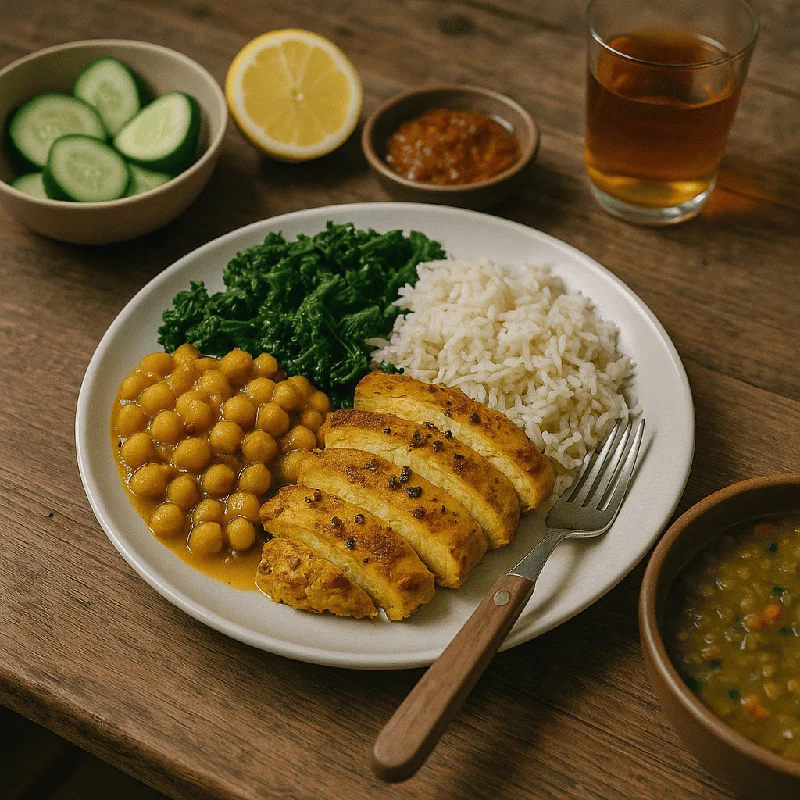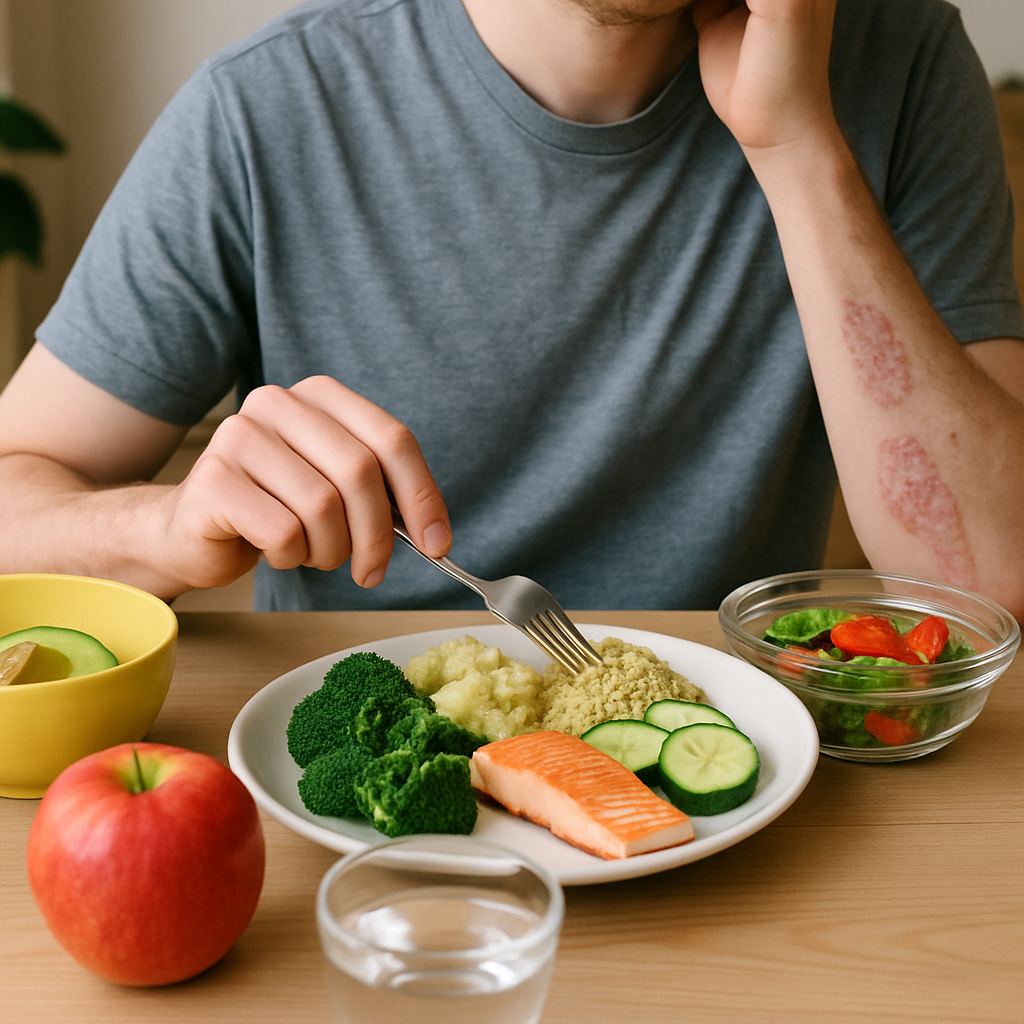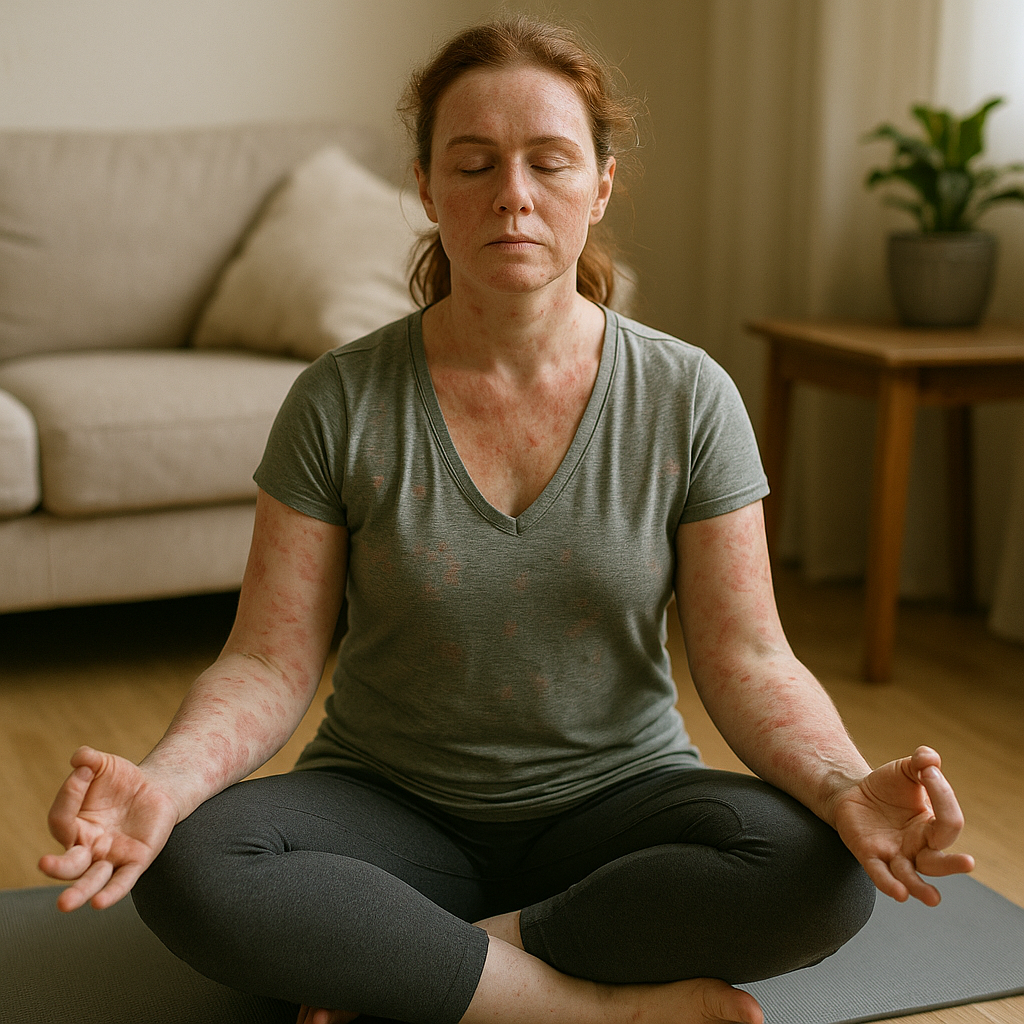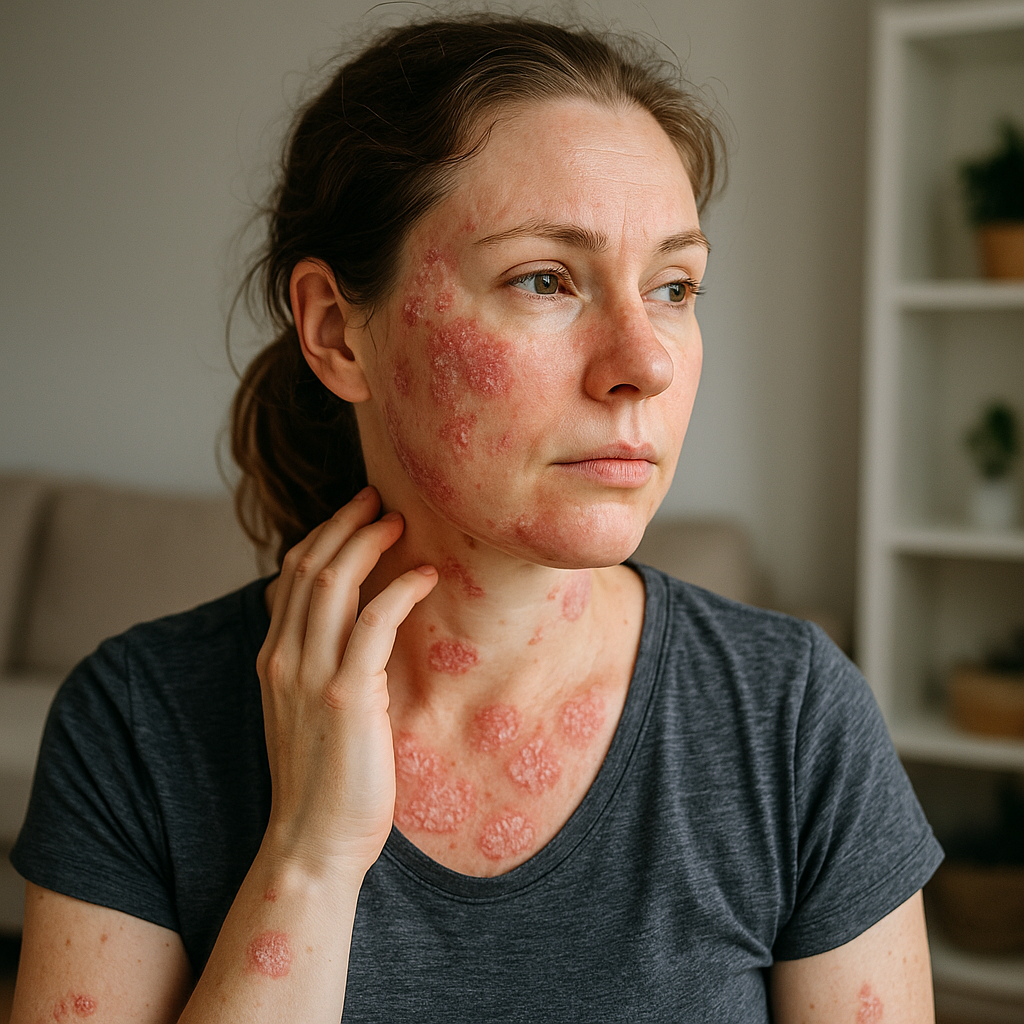Ask Ayurvedic doctor a question and get a consultation online on the problem of your concern in a free or paid mode. More than 2,000 experienced doctors work and wait for your questions on our site and help users to solve their health problems every day.
Shop Now in Our Store
The 7 Day Psoriasis Diet (Ayurvedic Edition): A Real-World Guide to Eating and Living for Skin That Feels Like Yours Again

Introduction to the 7 Day Psoriasis Diet and Ayurveda’s Approach
Let’s be honest — psoriasis sucks. It’s itchy, flaky, sometimes painful, and often leaves you dodging short sleeves or staring down jars of steroid creams that promise the moon and deliver a mild shrug. If you’re here, reading about a 7-day psoriasis diet, you’re probably hoping food and lifestyle tweaks might offer something better — not a miracle, but maybe relief that feels real, not just “topical.”
That’s where Ayurveda enters the picture.
Ayurveda, the traditional system of medicine from India that’s been around for over 5,000 years, doesn’t treat psoriasis like a disconnected skin problem. It sees it as a whole-body imbalance, often rooted in digestion (Agni), excess heat or toxins (Ama), and disturbed doshas — mainly Pitta and Kapha. It offers an entire philosophy around living and eating in ways that bring the body back into harmony — and your skin just happens to benefit as a result.
But this isn’t about drinking ghee or memorizing Sanskrit. This guide is practical, a little personal, and built to fit into your actual life. We’re focusing on what you can eat, what you should skip, how you can support your body with Ayurvedic routines, and what this looks like across just one week.
You’ll learn:
-
What foods can help reduce flare-ups from an Ayurvedic perspective
-
What lifestyle tweaks can make your gut (and skin) happier
-
Why stress, sleep, and even how you breathe can affect psoriasis
-
How to not screw it up (because yeah, some “natural” fixes backfire)
And — if all goes well — you might come out of these 7 days feeling a little less like you’re battling your body and a little more like you're teaming up with it.
Sound good?
Then let’s get into how Ayurveda sees psoriasis to begin with.
Understanding the Role of Ayurveda in Managing the 7 Day Psoriasis Diet
What Ayurveda Says About Psoriasis
Ayurveda calls psoriasis Kitibha, which falls under the broader category of Kushtha (skin disorders). It’s believed to result from an imbalance primarily in Pitta (the fiery dosha, responsible for digestion and metabolism) and Kapha (the heavy, slow, earthy dosha). The combination leads to the accumulation of Ama (toxins) in the system, which eventually manifests on the skin — sometimes as patches, other times as scaling, discoloration, and even burning or itching sensations.
Ayurveda doesn’t look at psoriasis in isolation. It links your skin health to your gut, your emotions, your daily rhythms, and the food that either nurtures or overwhelms your system.
So when someone with psoriasis walks into an Ayurvedic clinic, they’re not handed a one-size-fits-all herbal cream. Instead, the practitioner might ask about your digestion, your emotional state, your sleep, your cravings, even how often you feel cold or overheated.
It’s holistic — sometimes annoyingly so. But it works because the goal isn’t symptom control — it’s internal harmony.
How Ayurvedic Lifestyle & Diet Directly Impact Psoriasis
You know that saying: you are what you eat? In Ayurveda, it’s more like: you are what you digest, eliminate, and don’t accumulate as toxins.
Diet is seen as medicine, or if you ignore it — poison. Especially for conditions like psoriasis, the Ayurvedic diet focuses on foods that:
-
Cool excessive Pitta (think anti-inflammatory but in Ayurvedic terms)
-
Lighten Kapha (removing heaviness and stickiness)
-
Support digestive fire (Agni) without overheating it
-
Eliminate or prevent Ama (undigested waste that causes disease)
But it’s not just about what’s on the plate.
How you wake up, how stressed you are, whether you eat mindfully, and even if you eat at consistent times — all of this affects digestion and therefore your skin.
So yeah, it’s a lot. But once you get the hang of it, it stops feeling like “Ayurvedic rules” and more like common-sense rhythms that actually make your body feel better.
The Importance of Individualized Ayurvedic Approaches for Psoriasis
Here’s the thing: Ayurveda isn’t a universal diet plan. It’s personalized. A fiery, Type-A person in a cold climate with dry psoriasis needs a very different approach than a slow-moving, anxious person in a humid climate with weeping lesions. Even two people with the exact same skin symptoms might get two totally different sets of recommendations.
And honestly? That’s one of the best things about Ayurveda. It doesn’t reduce you to a diagnosis. It sees the whole, messy, unique version of you and creates a plan that fits you — not some mythical “average patient.”
So as you read through the rest of this guide, keep this in mind: what works for someone else might not be exactly what works for you. Listen to your gut (literally), and adjust accordingly.

Ayurvedic Dietary Guidelines for the 7 Day Psoriasis Diet
Food is a weird kind of double-edged sword when you have psoriasis. One bite can soothe your system or send your skin into full rebellion. In Ayurveda, this isn’t random — it’s biochemical, yes, but also energetic, seasonal, and tied to how your unique doshas are behaving that week.
Here's how you can structure your 7-day eating plan to work with your body, not against it.
Foods Recommended by Ayurveda for Psoriasis
We’re looking for foods that:
-
Reduce Pitta (cooling)
-
Dry out excess Kapha (light, non-greasy)
-
Don’t create Ama (easy to digest)
Your grocery list might include:
-
Steamed veggies: Think zucchini, carrots, bitter gourd, green beans. Avoid nightshades for now (bye, tomatoes).
-
Whole grains: Quinoa, millet, and old-school red rice (if digestion is strong).
-
Moong dal: Light, high-protein, and a skin-cleansing hero.
-
Aloe vera juice: Not everyone’s cup of “yum,” but wow, it helps cool inflammation.
-
Coconut water: Soothes the gut, hydrates deeply — it’s basically tropical skin therapy.
-
Turmeric: Anti-everything — inflammation, bacteria, toxins.
-
Ghee: A little goes a long way; nourishes tissues without clogging.
Small note: Just because it’s “Ayurvedic” doesn’t mean it’s boring. You can make all this taste great. Think: cumin-spiced moong dal with a squeeze of lime and coriander on top.
Foods Ayurveda Suggests Avoiding for Psoriasis
Some of these may feel harsh. But give it 7 days — you’re not breaking up with them forever, just pausing the relationship to see how your skin responds.
Avoid:
-
Fermented foods: Including yogurt, pickles, vinegar — they aggravate Pitta and Ama.
-
Nightshades: Tomatoes, potatoes, brinjal/eggplant — often linked to flare-ups.
-
Excessive salt or spicy foods: Fuels the fire of inflammation.
-
Red meat and seafood: Heavy and heat-producing, especially in combo with dairy.
-
Dairy + fish/meat together: Huge Ayurvedic no-no. Creates toxic byproducts.
-
Cold drinks and raw salads: Can dampen your digestive fire (Agni), making it harder to clear toxins.
If you're thinking, "But I love yogurt!" — yeah, same. But skin wins this round.
Meal Planning and Timing Tips in Ayurveda for Psoriasis
Meal timing is so underrated. In Ayurveda, when you eat matters almost as much as what you eat.
-
Biggest meal = lunch, when digestive fire is strongest.
-
Breakfast = light but grounding (like a warm rice porridge or fruit stew).
-
Dinner = early and small, ideally by sunset or 7pm latest.
-
Avoid snacking unless you're genuinely hungry — let the system rest and digest fully.
-
No eating while angry, anxious, or watching chaos TV — your stomach listens more than you think.
It’s all about rhythm. Your body loves routine — even if your mind doesn’t.
Hydration and Beverage Recommendations for Psoriasis
-
Warm water: Sip throughout the day. Cold water? That’s a no.
-
Coriander seed tea: Excellent Pitta-pacifier.
-
Cumin + fennel tea: Helps digestion and detoxification.
-
Aloe vera juice (morning): Just a couple of tablespoons — it cools internal heat.
Skip coffee, alcohol, sugary juices. Yes, even kombucha. Ayurveda’s got beef with fermentation during flare-ups.
Ayurvedic Lifestyle Practices Specifically Beneficial for Psoriasis
You can eat clean and still flare if the rest of your life is chaotic. Ayurveda calls it Dinacharya — your daily rhythm. And for psoriasis, this rhythm is everything.
Daily Ayurvedic Routines (Dinacharya) to Manage Psoriasis
-
Wake early (before sunrise) — the air is still, digestion resets, and your cortisol hasn’t spiked yet.
-
Tongue scraping: Removes Ama first thing.
-
Oil pulling: Optional but beneficial. Keeps inflammation in check.
-
Abhyanga (self-massage with medicated oil): Before shower. Use neem or coconut-based oils to calm the skin.
-
Warm shower, not hot: Avoid stripping natural oils.
-
Midday walk: Aids digestion and boosts mood.
-
Evening wind-down ritual: No screens, some soft music, light stretching.
This isn’t about perfection. If you only manage three out of seven in a day? That’s still better than zero.
Sleep Patterns and Ayurvedic Guidelines Relevant to Psoriasis
-
Sleep by 10pm. After that, Pitta kicks in again — your body wants to clean house, not scroll TikTok.
-
Don’t oversleep either — 6.5 to 8 hours is ideal.
-
Avoid eating or thinking heavy things late at night — it messes with your system’s nightly detox cycle.
Ayurveda considers poor sleep a root cause of skin disorders. Yep, it’s that important.
Ayurvedic Personal Care Practices for Psoriasis
-
Herbal baths: Neem or triphala decoction in warm water soothes itching.
-
No synthetic soaps: Use natural, unscented cleansers.
-
Avoid scrubbing the skin. It's already inflamed — be kind.
-
Oil before shower, not after: That way, it penetrates instead of just sitting on top.
Sometimes, the smallest switches — like changing your soap — are what finally unlock healing.

Yoga & Breathing Techniques for Psoriasis
This part isn’t just a “bonus” — it’s where deep shifts happen. Because if you’re constantly stressed, inflamed, and disconnected from your body, diet alone won’t cut it.
Yoga Asanas Specifically Recommended for Psoriasis
Focus on calming, Pitta-pacifying poses. No hot yoga or super-aggressive power flows.
Try:
-
Child’s pose (Balasana)
-
Seated forward bend (Paschimottanasana)
-
Cat-cow (Marjaryasana-Bitilasana) — helps gut and spine.
-
Spinal twists
-
Legs-up-the-wall (Viparita Karani) — the holy grail of cooling.
Even 20 minutes a day can reset your nervous system.
Pranayama (Breathing Exercises) That Improve Psoriasis
-
Sheetali / Sheetkari (cooling breath): Literally lowers heat in the body.
-
Nadi Shodhana (alternate nostril): Balances energy channels.
-
Bhramari (humming bee breath): Insanely calming — reduces emotional triggers.
Don’t overdo it. These are gentle tools. 5–10 minutes daily is plenty.
How Often to Practice Yoga & Breathing Techniques
-
Daily, ideally mornings for yoga and evenings for pranayama.
-
Don’t push or rush. This isn’t about sweating — it’s about soothing.
-
Restorative yoga works better than ambition here.
If you’ve ever done just five minutes of deep breathing and noticed your skin stop tingling — you already know how real this is.
Stress Management and Emotional Health Advice for Psoriasis
There’s no point sugarcoating it — stress wrecks skin. And psoriasis is a condition where mind and body are intimately tied.
Ayurveda treats emotions like weather systems — they come, go, but need to be observed and understood.
Ayurvedic Techniques to Reduce Stress Related to Psoriasis
-
Nasya: Oil drops in the nose with calming herbs like brahmi or shankhpushpi.
-
Shirodhara (if you can access it): Medicated oil gently poured on the forehead. It’s like therapy and sedation had a baby.
-
Aromatic therapy: Essential oils like sandalwood, rose, and vetiver are cooling and grounding.
You don’t need a spa. Even five drops of Brahmi oil massaged into your scalp at night can be deeply grounding.
Meditation and Mindfulness Practices Beneficial for Psoriasis
-
Trataka (candle gazing): Calms racing thoughts.
-
Mantra meditation: Repeating “Om Shanti” or “So Hum” — rhythmic, soothing.
-
Walking meditations: Barefoot on grass if possible.
You don’t have to sit cross-legged and chant. Just notice your breath, notice your thoughts, and let your body know it’s safe.
Emotional and Psychological Considerations in Ayurveda for Psoriasis
Ayurveda doesn’t separate “skin flare” from “emotional flare.” Pitta-driven emotions — anger, frustration, competitiveness — can ignite symptoms.
Some honest-to-goodness practices?
-
Journaling: Especially about things you’re “burning” to say.
-
Therapy: Western or Ayurvedic — doesn’t matter. Talk it out.
-
Community: Being seen by others (psoriasis and all) is part of healing.
Practical Ayurvedic Home Remedies and Recipes for Psoriasis
You don’t need a lab or a PhD in Sanskrit to benefit from Ayurvedic remedies. What you do need? A few ingredients, some patience, and a willingness to try weird-smelling pastes that may, surprisingly, work wonders.
Simple and Effective Home Remedies for Psoriasis
-
Neem Paste (external)
-
How to: Grind neem leaves with a little water and apply as a paste to affected areas. Let dry. Rinse with lukewarm water.
-
Why it works: Neem is antibacterial, antifungal, and an Ayurvedic go-to for almost all skin disorders.
-
-
Aloe Vera + Turmeric Gel (external)
-
How to: Mix pure aloe gel with a pinch of turmeric. Apply at night.
-
Bonus: Keep it in the fridge for a cooling effect on flare-ups.
-
-
Manjistha Powder (internal or topical)
-
Use: Drink ½ tsp in warm water daily OR mix with rose water as a face/body pack.
-
Caution: Always consult an Ayurvedic practitioner before internal use.
-
-
Coconut Oil + Camphor (external)
-
How to: Melt coconut oil, add a pinch of edible camphor, let it cool, and apply to scaly skin.
-
None of these are overnight fixes. But give them a few days and watch the magic quietly begin.
Ayurvedic Recipe Ideas Specifically Beneficial for Psoriasis
These are meant to be simple, warm, and digestible. Nothing fancy. Think of them like medicine in food form.
-
Moong Dal Khichdi: With cumin, turmeric, and seasonal veggies.
-
Stewed Apples with Cloves: Gentle, gut-friendly breakfast.
-
Bottle Gourd Soup (Lauki): Cooling and easy on digestion.
-
Coriander Rice with Ghee: Light lunch for Pitta types.
-
Triphala Tea (before bed): Detoxifies gently.
These aren’t meals to impress guests. They’re meals to make your gut and skin go, thank you.
Preparation Tips and Guidelines for Ayurvedic Remedies
-
Always use warm, not boiling water when mixing powders.
-
Avoid microwaving — Ayurvedic logic prefers stovetop warmth.
-
Cook with intention. Sounds woo, but it matters.
-
Use fresh herbs when possible.
-
Be patient. Some herbs take days to build effect.
And remember: consistency over perfection.
Common Mistakes & Misconceptions About Ayurvedic Lifestyle for Psoriasis
It’s easy to get swept up in the “natural = safe” fantasy. But Ayurveda’s subtle — and powerful. Missteps can slow your progress or even make things worse.
Common Myths About Ayurveda & Psoriasis
-
“It’s just herbs”: Nope. Ayurveda is a complete medical system, not a kitchen witch’s recipe book.
-
“If it’s Ayurvedic, I can use it freely”: Wrong. Some herbs aggravate certain doshas.
-
“I can skip diet and just use oils”: That’s like mopping up a leak without fixing the pipe.
-
“Ayurveda takes years to work”: Not always. Many feel shifts in days or weeks.
Typical Mistakes People Make When Adopting Ayurvedic Lifestyle for Psoriasis
-
Mixing incompatible foods (fish + yogurt is the infamous duo)
-
Overdoing the oils and self-massage without proper detox
-
Taking random herbal supplements from the internet
-
Expecting Western-style symptom suppression
-
Ignoring seasonal shifts in their dosha balance
How to Avoid These Mistakes
-
Start slow: One new practice at a time.
-
Track changes: Keep a food + symptom journal.
-
Check in with a qualified Ayurvedic practitioner.
-
Listen to your body: If something feels off, it probably is.
-
Don’t force anything. Ayurveda is gentle by nature.
Real-Life Success Stories & Testimonials Related to Psoriasis
Sometimes you need to hear from someone who’s been there — not just a list of rules.
Inspirational Stories from Individuals Who Improved Psoriasis Through Ayurvedic Lifestyle
“I tried everything for 9 years. Topical steroids, UV light therapy, elimination diets. What worked? A combination of Abhyanga oil massage, khichdi for lunch every day, and breathing exercises I used to think were silly. My plaques didn’t vanish overnight, but they stopped spreading. That was the biggest win.”
— Maya, 34
“My teenage son had scalp psoriasis. We switched out his snacks for fruit and spiced teas, added yoga into his routine. It’s not perfect, but he can wear black shirts again without worrying about flakes. That’s enough for now.”
— Anil, 42
Real-world Benefits & Results Achieved Using Ayurvedic Recommendations
-
Reduced flares during seasonal changes
-
Less itching and faster healing of lesions
-
More energy and less digestive distress
-
Improved mood + better sleep
Not everyone gets dramatic results. But almost everyone feels some positive shift.

Scientific Evidence Supporting Ayurvedic Lifestyle & Diet for Psoriasis
Science is (slowly) catching up with ancient wisdom. While large-scale randomized trials are limited, the research we do have is compelling.
Research Findings About Diet’s Impact on Psoriasis
-
Diets low in inflammatory foods (sugar, processed meat) reduce psoriasis severity.
-
High-antioxidant, plant-forward diets have been linked to fewer flares.
-
Ayurveda-inspired elimination diets improve gut microbiota, which directly impacts skin.
Clinical Studies Confirming the Benefits of Ayurvedic Practices
-
Aloe Vera Gel: Found to reduce plaque psoriasis symptoms comparably to topical steroids in some studies.
-
Turmeric (Curcumin): Anti-inflammatory powerhouse; shown to reduce psoriatic inflammation markers.
-
Panchakarma Detox Therapies: Early studies show reduction in PASI (Psoriasis Area and Severity Index) after guided Ayurvedic detox.
Expert Opinions on Ayurvedic Approaches to Psoriasis
Dr. Gopal Tiwari (B.A.M.S.):
“Psoriasis management is not just topical. Until digestive fire is addressed, skin cannot heal.”
Dr. Elizabeth Boham, M.D. (Functional Medicine):
“What ancient systems like Ayurveda knew about food, stress, and skin is now being validated by modern science.”
Conclusion & Summary of Ayurvedic Recommendations for Psoriasis
If you’ve read this far, you’ve probably realized something important: psoriasis is not just a skin thing.
It’s a gut thing. A digestion thing. A lifestyle thing. A you thing.
Ayurveda doesn’t promise quick fixes — it offers deep, systemic realignment. In this 7-day plan, even if you only adopt half the suggestions, your body will notice.
Let’s recap:
-
Eat warm, simple, Pitta-pacifying meals.
-
Avoid dairy + meat combos, heavy snacks, nightshades, and alcohol.
-
Stick to regular meal and sleep times.
-
Add cooling, calming yoga and breathwork.
-
Use simple home remedies like neem, aloe, and manjistha.
-
Address stress with meditation, herbs, and journaling.
-
Watch your skin and your mind slowly soften.
Next steps?
Talk to an Ayurvedic doctor. Ask questions. Start small. Don’t wait for a flare-up to listen to your body.
Your skin might just be trying to get your attention — and Ayurveda is here to help you understand what it’s saying.
Frequently Asked Questions (FAQ) about Ayurvedic Lifestyle for Psoriasis
Q1: Can I really improve psoriasis in just 7 days with Ayurveda?
You may not “cure” it in 7 days, but you can absolutely reduce flare-ups, soothe inflammation, and feel better — both mentally and physically.
Q2: Do I need to follow a strict Ayurvedic detox (Panchakarma) for results?
Not necessarily. This guide is gentle and food-focused. Panchakarma can help but isn’t required for everyone.
Q3: Are there any Ayurvedic herbs I should avoid for psoriasis?
Yes — spicy, heating herbs like ashwagandha can aggravate some people with Pitta dominance. Always consult a practitioner.
Q4: Can I eat dairy on the 7-day psoriasis diet?
In moderation, and only if it’s properly combined (never with fish/meat). Prefer warm, spiced milk over cold or fermented dairy.
Q5: Is stress really that big of a factor in psoriasis?
Yes. It can trigger or worsen flares. That’s why breathing, sleep, and emotional care are essential parts of Ayurvedic healing.
This article is checked by the current qualified Dr Sujal Patil and can be considered a reliable source of information for users of the site.

